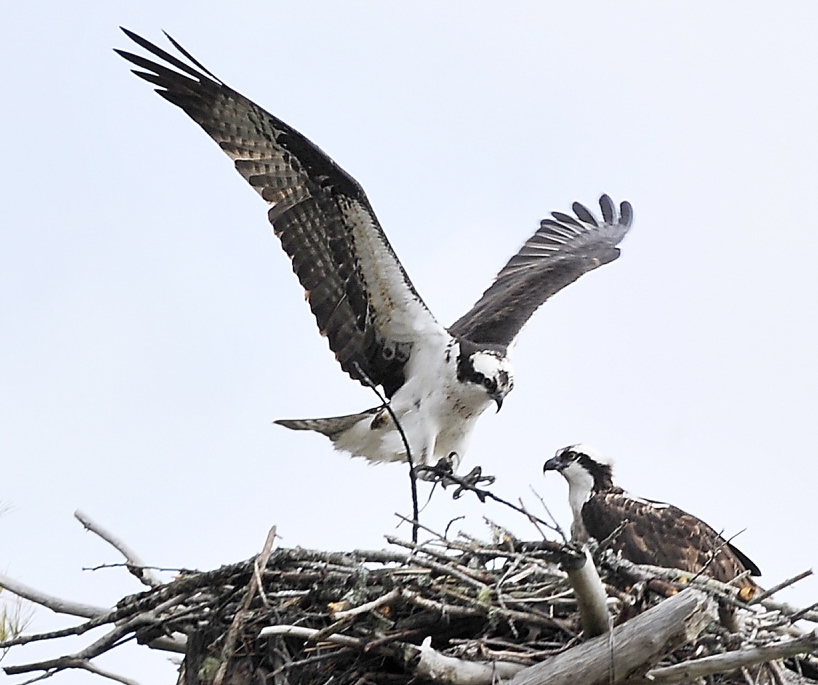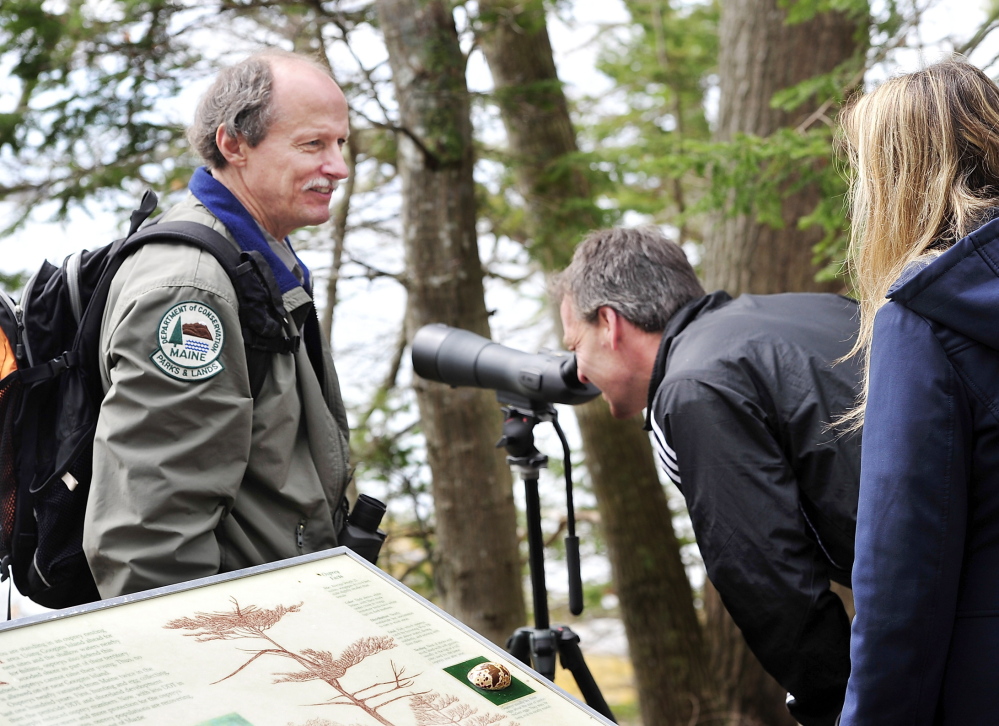FREEPORT — An hour and a half, and a 200-yard walk. That’s all it takes to experience the osprey nature show playing out daily at Wolfe’s Neck Woods State Park in Freeport.
In just a few hours on any spring or summer day, visitors to the 250-acre park can observe the tasks of these active and animated birds – nesting, fishing and defending their territory – played out in the wild.
“It’s amazing the regularity with which you see osprey do any of these things,” said Park Manager Andy Hutchinson. “People ask if we have them trained but we don’t.”
Wolfe’s Neck Woods’ resident ospreys will be a feature of the Feathers over Freeport festival taking place Sunday. It’s part of the area’s fourth annual birding festival, which is geared for beginner naturalists. The festival takes place at Bradbury Mountain State Park in Pownal in addition to Wolfe’s Neck Woods.
Activities offered Sunday include birding walks, youth nature programs and a live raptor demonstration by a wildlife rehabilitator. But people need not participate in the annual birding festival to see the “fish hawks,” as osprey are also known, up close and active in Freeport.
On a foggy morning last week, Hutchinson led two visitors to two osprey nesting sites – one that has been documented on Googins Island for two centuries – and another beside a salt marsh. A third nest exists next to the Harraseeket River.
“For centuries osprey have been nesting on Googins Island. It was named that in the early 1800s after a town selectman,” Hutchinson said. “But prior to the 1800s it was called Fish Hawk Island.”
When the Googins Island nest proved too socked in by fog to offer a clear view of the birds, Hutchinson walked five minutes down the park trail to the nest at the salt marsh. Within a 30-minute span, a virtual osprey documentary played out a few weeks after the birds had returned from South America, where Maine’s osprey winter.
As the female osprey waited in the nest, the male bird flew in and landed beside her, carrying sticks to add to their home. Hutchinson explained they’ll start the nesting season with sticks, then add mud and seaweed.
“I’ve been walking in the forest and heard them break off the branch of a pine tree. They don’t pick sticks off the ground so they won’t be vulnerable to predators,” he said.
The next moment the female osprey is left alone again at the nest, where she waits for several minutes. Until she starts calling.
Hutchinson explains the high-pitched calls to her mate are not the agitated alarm used when a predator is near. Her sounds are softer, more of a greeting call.
“He must have gone fishing, and he’s got a fish and is nearby eating it. She wants some. They usually eat it on a tree nearby. Then he’ll bring half to her,” Hutchinson said.
And as if on cue, the male bird swoops up from under the nest, lands softly beside his mate with a fish in his formidable talons and leaves it for her, like nature’s gift.
This is the classic Wolfe’s Neck Woods show, compliments of its signature critter.
“Last year there were six fledgling osprey,” Hutchinson said proudly of the newborn osprey in 2013. “This year we could have nine.”
Osprey have never been listed as endangered in Maine or by the federal government, but nationwide their numbers dropped in the 1970s. According to the Biodiversity Research Institute in Gorham, osprey today are a success story – proof that Maine’s ecosystem is healthier than it was a half-century ago when the pesticide DDT was used.
An estimate done last year showed roughly 1,000 nesting pairs in the state, according to Maine raptor biologist Erynn Call. According to Call, state biologists believe the statewide population continues to thrive in some parts of Maine better than others.
Casco Bay is one such place where the birds have a strong foothold. And Wolfe’s Neck Woods State Park is a fine example of that.
“It’s more of a shifting theme. They’re not hanging on in some places as well as they did 30 years ago, but they are doing better in other areas,” Call said.
“One important factor for osprey affecting where they do well and where they don’t is fish prey. In Casco Bay there is an abundance of fish prey.”
Deirdre Fleming can be reached at 791-6452 or at:
dfleming@pressherald.com
Twitter: FlemingPph
Send questions/comments to the editors.





Success. Please wait for the page to reload. If the page does not reload within 5 seconds, please refresh the page.
Enter your email and password to access comments.
Hi, to comment on stories you must . This profile is in addition to your subscription and website login.
Already have a commenting profile? .
Invalid username/password.
Please check your email to confirm and complete your registration.
Only subscribers are eligible to post comments. Please subscribe or login first for digital access. Here’s why.
Use the form below to reset your password. When you've submitted your account email, we will send an email with a reset code.